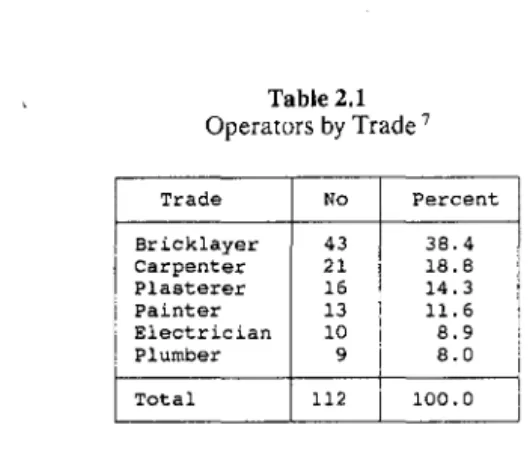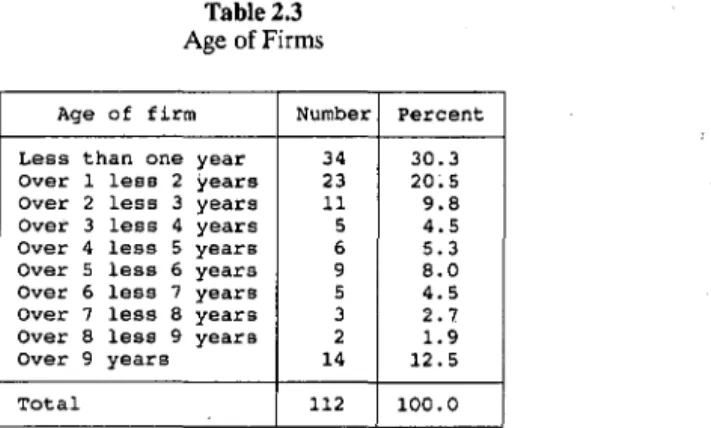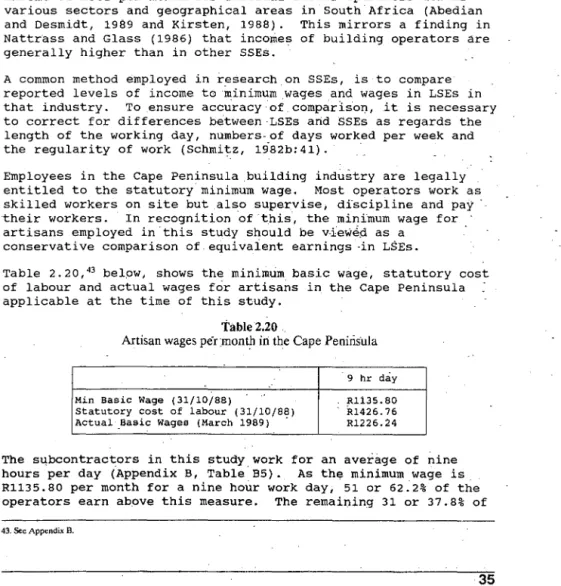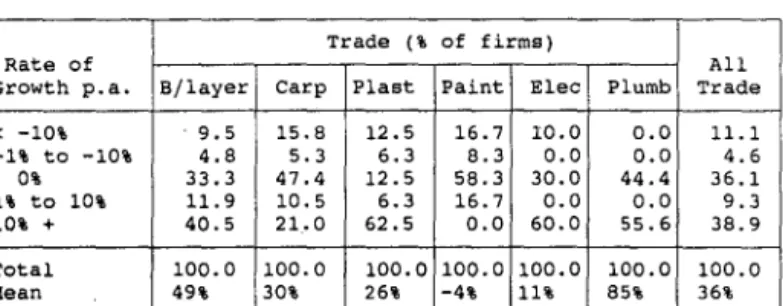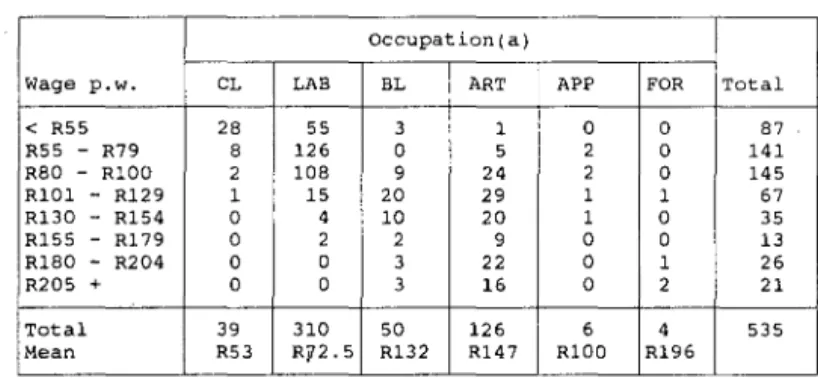BACKGROUND AND METHODOLOGy
INWARD INDUSTRIALISATION
The identification of the construction sector as a leading sector has a precedent in the Colombian "Development" program. In the Colombian experience, SSEs were particularly prominent in providing temporary and permanent shelter for the urban poor (see Currie, 1971 and 1974).
HOUSING
This thesis can be seen as a contribution to the internal industrialization debate, focusing on the relationship between policy and SSE in the housing industry. While SSE and subcontractors have traditionally been important in the construction industry, their use has increased in recent times.
SSEs AND THE SOUTH AFRICAN CONSTRUCTION
- The Structure of the Construction
The share of companies of different sizes in the construction sector is shown in Table 1.1 below. Subcontracting in the construction sector Year % Stibcontract(a). a) part of gross production allocated to subcontractors. Source: Census of Construction, 1972-1985.
METHODOLOGY
- Choice of Sites . . . . . . . . . . . . . . . • . . . . . . . . "
- Interviews
- Reliability of Data
This column shows on-site wages as a proportion of statutory labor costs in the region.·. This chapter concentrated on the characteristics of the firms, operators and workers in the sample.
A PROFILE OF SUBCONTRACTORS IN THE CAPE
The Operators
The size of the sample of operators and the distribution of activities within the sample are shown in Table 2.1.6 A total of 112 operators were interviewed at the two sites. For an introduction to the Cape Peninsula construction industry see Appendix A and the original thesis (Krafchik, 1990:206).
Most workers were hired for the job, after which their employment prospects depended on those of the operator.
Period Engaged in Activity
Registration
Finally, where operators were caught violating the regulations, the fines were quite small.
ENTREPRENEURSHIP AND MANAGEMENT
- Motivation
- Technical Skills
- Formal Education
- Vocational Training
- On-the-job Training
- Organisational Skills
- Bank Account
- Calculation of Cash Flow
- Bookkeeping system
- Other Indicators of Management
In wet crafts and painting, a much smaller proportion (average = 52%) of entrepreneurs were qualified craftsmen. Furthermore, 73.2% of operators had industry experience above the level of an unskilled worker.
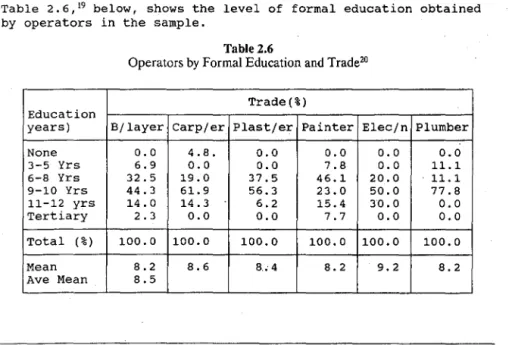
CAPITAL ...•.••.•• " •
- Size of Initial Capital. .••.••.•
- Productivity of Capital., . . • . . . . . • . . " ••.••
- Cost of Job creation •••
The amount of start-up capital required to start a business is an indication of the financial barriers to entry into the sector. The rest of the variation in start-up capital requirements is explained by differences in equipment costs across trades.
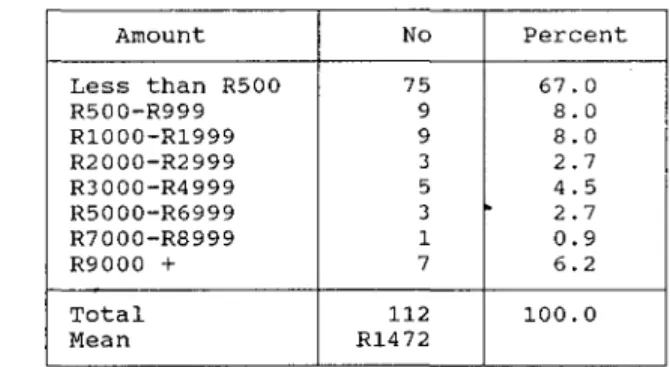
INCOME
- Income on Site
- Income per Annum
- Comparative Analysis of Operators'
- The Determination of Income
In short, after adjusting for differences in the length of the working day and the irregularity of employment, the majority of entrepreneurs in this study earn more than the minimum basic wage for artisans in the industry. An explanation of the economic reasoning behind these variables is shown in Appendix D. The initial results and the model with the best explanatory power are shown below in Tables 2.21 and 2.22 respectively. By including the variable in Table 2.23, the model can explain 47% of the variation in income per year.
The best explanatory variables that House (1984) included in his stepwise regression explain 33% of the variation in income, while Chuta and Liedholm's (1985) results explain 58% of the variation in income. More than half of the entrepreneurs in the sample earn above the minimum wage for craftsmen in the construction sector.
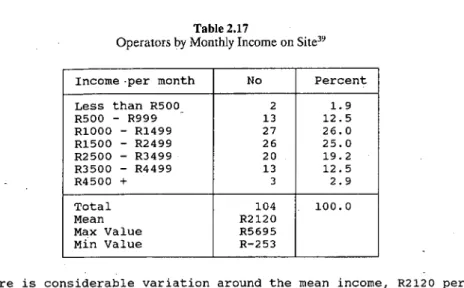
LABOUR
- Employment and Composition of the
- Education and Training
- Rates of Growth of Employment
- Relative Labour Intensity
As the vast majority of skilled workers are not skilled craftsmen, the sector's potential to employ particularly unskilled labor is even greater than indicated above. Of the 183 persons employed as artisans in the sample, they did not have a relevant trade qualification. The employment of unskilled workers for skilled work is prohibited under the Industrial Council agreement for the region (see Appendix A).
It was previously noted that most operators interviewed had not acquired their own skills in the SSE sector. Apart from the doubling of some jobs (such as cement trading), the scale of job creation would not differ depending on the size of the company.
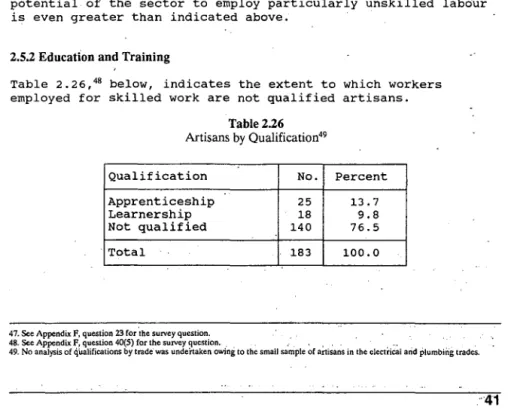
WAGES
- Wages per Week
- Comparative Analysis of Wages
- Summary
It is illustrative to compare the local wage rates with the costs of +iving and the statutory labor costs in the region. Comparison of on-site pay with statutory labor costs on the Cape. Source: Statutory Labor Costs from Industry Council Agreement for the .Cape Peninsula as Revised.
The statutory labor cost indicates the total labor cost in terms of the Industrial Council agreement. On average, wages in the country are 50% lower than the statutory labor cost as specified in the Industrial Council agreement.
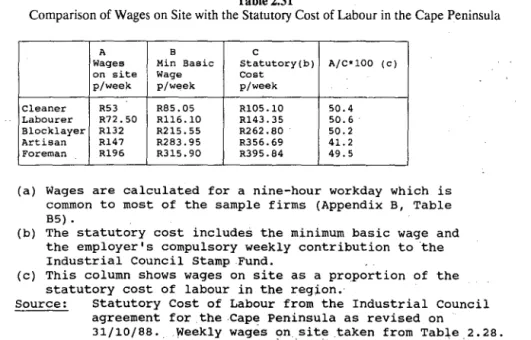
PRODUCT QUALITy
CONCLUSIONS
This means an examination of the reasons for subcontracting LSEs in industry and the constraints that subcontractors face. The terms of the Industrial Council Agreement are extended to all firms in the industry in terms of section 48 of the agreement (see Appendix A). Traditional employment codes in the construction industry have taken into account the variability of production in the industry.
The result places significant limits on the number of subcontractors who can find employment in the industry. It happened in the context of housing privatization in South Africa and in particular the promotion of internal industrialization. Reduction of inequality in the subcontracting relationship, which initially relies on the provision of individual plots of residential land.
This can be achieved through greater differentiation in prices and structures of the houses produced. One of the unfortunate externalities associated with deregulation in the construction industry is its discouragement of certified apprenticeships. Reference is made to the following tables, where relevant, in the body of the thesis.
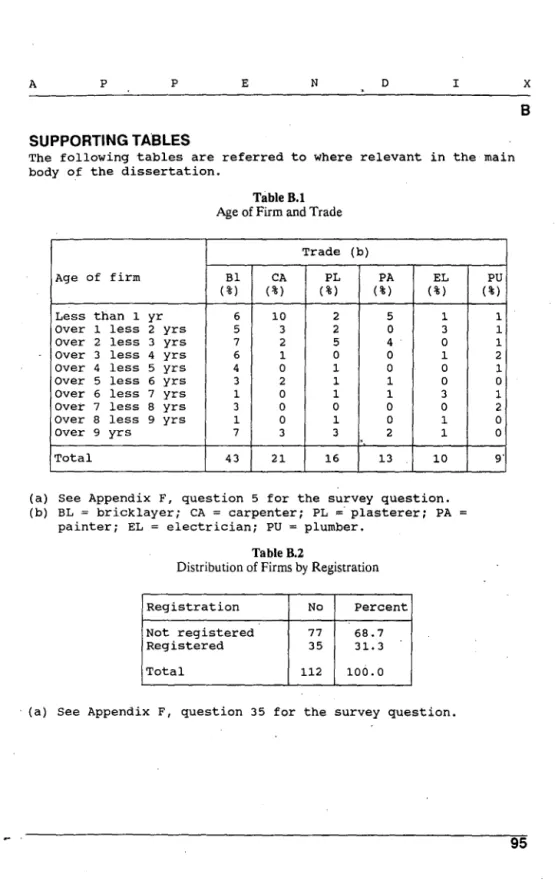
THE CONTRACTORS PERSPECTIVE
TRADE UNIONS
Each of the contract managers interviewed argued that unionization in the construction industry, as in some other industries, has significantly encouraged subcontracting. The process allowed the LSE to divest itself of liability for redundancy, workers' pay and costs associated with strikes and absenteeism. The very low proportion of unionization in the sector can be explained by a number of factors, including high turnover of firms, small size of firms, recent entry of firms, the level of unregistered activity in the industry and the extent of unemployment. in the region.
The relatively high level of union membership among registered workers in LSEs thus provides a further rationale for subcontracting. Fergus (1983) writes about the European experience and provides an important warning: . One consequence of [subcontracting] is that there are many misunderstandings between the labor movement, which sometimes sees the 'dispersed' worker as docile, passive and of marginal significance, and the labor movement.
FINANCIAL PLANNING
THE CYCLICAL NATURE OF THE BUILDING INDUSTRY
A similar study was carried out by the Cape Town City Planners Office (City of Cape Town, 1988) for colored housing in the Western Cape. The affordable housing industry in the Cape Peninsula is not currently one of these cases. Small business, inward industrialization and housing: A case study of subcontractors in the low-cost housing industry in the Cape Peninsula.
Here it is assumed that record keeping will increase the managerial ability of the operator and thereby affect the revenue generated in the firm. The reason is the greater skill intensity of the work involved in the earlier trades, and the relative supply and demand for skills in all occupations.
THE CONSTRAINTS FACED BY SUBCONTRACTORS •••••••• 61
SUPPLY OF LAND
For example, Hendler estimates the extent to which official land allocation in the PWV region lags behind the land needed for housing. If the amount of land available to blacks is an obstacle to the supply of housing, so too is the distance to workplaces. The artificial scarcity of land imposed by the law exacerbates the affordability problem by increasing the price of land, especially in those areas where land shortages are greatest.
In the Cape Province, Whites can get plots in Table View at half the price of comparable land in areas demarcated for Coloureds. In short, state land allocation policies and the Group Areas Act limit the amount of suitable land available for low-cost housing and prevent the full use of existing land supplies.
ACCESS TO FINANCE
This means that any increase in housing supply, even if the affordability problem were avoided, would be severely curtailed by the undersupply of suitable residential properties. On the other hand, constraints on the provision of affordable housing limit the scope for growth of existing subcontractors and the entry of new companies into the industry.
THE SUBCONTRACTING RELATIONSHIP
- Raw Material Shortages
- Rates of Pay
- Insecurity of Contract
The situation is such that with the exception of some electricians and plumbers, the contractor takes responsibility for providing the raw material". The entire direct cost of delay is borne by the subcontractor, which limits revenue generation within the subcontracting firm. The negative or positive return received by each of the firms is expressed as a percentage of the wage rate for the work undertaken.
Finally, a number of subcontractors complained about factors attributable to the uncertainty of the contract. In short, each of the three factors above limits the growth of subcontracting firms and the amount of employment and income generated.
INTERNAL MANAGEMENT
This is based on the records of the developers, and excludes those subcontractors who have not received a single payment. Given these factors, it was not surprising that a large proportion (42.5%) of operators cited some aspect of subcontracting as one of the main factors limiting the growth of their firm (Appendix B, Table B11). Moreover, when asked for what purpose they would use a gift of R10 000, most operators responded that they would continue to work in the construction industry, but outside the subcontracting sector (Table 2.5).
In addition, a large proportion of operators demonstrate sufficient technical competence to manage the company. In this way, the sector can serve as a useful training ground for the development of managerial resources in the country.
CONCLUSION .. "
This conclusion will integrate the results of the case study into an assessment of inward industrialization. The exact reduction depends on the extent to which lower labor costs filter through to the price of the house. If it does not lead to a more than proportional increase in the effective demand for housing, then the net effect is simply the redistribution of the proceeds of housing production from subcontractors to LSEs and subcontractors.
If the houses were built in LSE without subcontracting, on-site wages would be 40% higher and the house price would be 10% higher. Reworking the above calculations on this basis shows that the net effect of the trend is k.
POLICY GUIDELINES AND ISSUES FOR FUTURE RESEARCH
- Afiordability . •
- The .Subcontracting Relationship
- Land Policy
- Management and Skills Training
- Management Training
- Skills Training
- Conclusion
The request is for tile-State to adopt more flexibility in allotting plots of different sizes for development. Upon registration, the employer must make a deposit with the Industrial Council to cover liabilities in the event of insolvency. The cost of tool and equipment depreciation is not included in the revenue calculation.
The reason is that an apprenticeship or traineeship provides the operator with the technical knowledge needed to work in the industry. The underlying reason is the experience gained in dealing with the real vicissitudes involved in the industry. The rationale is that the greater the number of workers in the firm, the greater the scale at which the firm can operate.
For how many months in the past year was your business able to find work in the construction industry?
